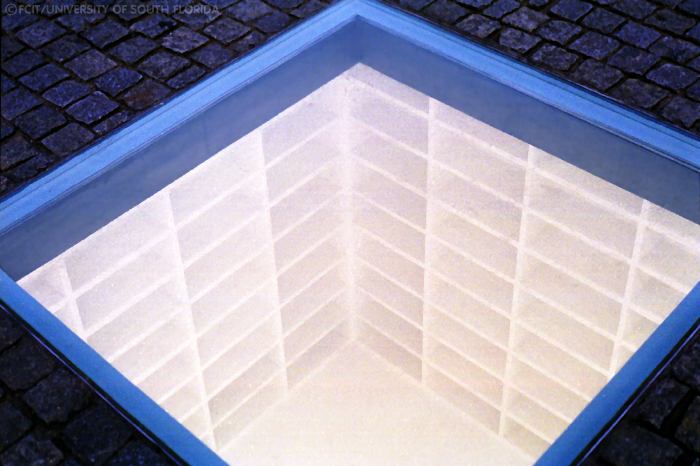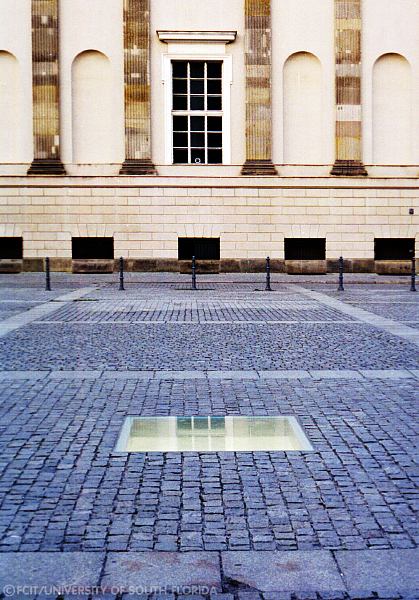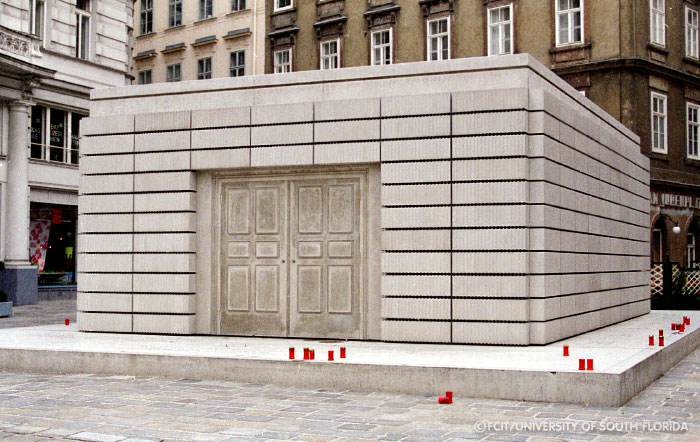International Holocaust Remembrance Day falls on January 27. Over the past several decades, I’ve taken thousands of photos of Holocaust-related monuments across Europe for one of our projects. Most such monuments, of course, are intended to memorialize the victims of National Socialism. However for this post, I’ve selected two photos that speak also to a cultural loss.
One photo is from Berlin and the other from Vienna. They share a library theme, thereby providing a rich opportunity to compare and contrast the message of the two artists who designed them.
The Empty Library, Micha Ullman

On May 10, 1933, students of the National Socialist Student Union and many professors of the nearby university burned over 20,000 books that had been banned by the government. The burning took place in front of the university’s library in a square now known as Bebelplatz.
In 1995, a monument by Micha Ullman was dedicated at Bebelplatz. It is an underground library room with shelves enough to hold the 20,000 books that had been destroyed some sixty-two years prior.
There is a plaque nearby with a quotation by Heinrich Heine:
“Where they burn books,
they will in the end burn people, too.”

Click for additional photos of this memorial.
Not many years ago, the sculptor gave a tour of the monument to a small group of artists. Here are some of the things he said as reported in Haaretz.
“You can see the emptiness and the silence. Those are the two important materials the monument is made of.”
“When I look at the glass I see the sky’s reflection. In Berlin’s case – there are usually clouds too. As far as I’m concerned, they’re like smoke. So the books in the library are burning almost every day.”
The Nameless Library, Rachel Whiteread

The second photo is of Rachel Whiteread’s memorial in Judenplatz in the city of Vienna. It was intended to commemorate the 65 thousand Austrian Jews murdered during the Holocaust. The memorial sits adjacent to the site of a synagogue destroyed in 1421 during the expulsion of Jews from Vienna.
As with many works of art, there can be several interpretations. I’ll try to describe the details without leading the reader too much. The sculptor is known for her work of making negative casts. This nameless library, however, is made of positive concrete casts of book shapes. The books are set with the spines inward so not even the titles can be read, let alone the books themselves. The shelves are represented by the empty spaces. The doors are negative casts with no handles, so the space cannot be entered.

Click for additional photos of this memorial.
When the monument was dedicated in 2000, Simon Wiesenthal told the assembled audience, “This monument shouldn’t be beautiful. It must hurt.”
Discussion
Here are a few questions to start or fund a class discussion about the photos.
- How are the two memorials similar? How are they different?
- Many Holocaust memorials are about the numbers of people who lost their lives. The Judenplatz memorial does, indeed, have an inscription about the number of Austrian Jews who were killed. But what else are these memorials referring to?
- The idea of the “void” frequently appears in Holocaust memorials. An entire museum in Berlin was designed around that concept. How do these two memorials reflect a void?
- Can you think of a memorial in Washington, DC, that is not a Holocaust memorial, but also uses the idea of the void? What is it and what does it represent?
- Neither memorial was designed to be “pretty.” The Bebelplatz memorial can be rather creepy at night with a weird light coming up from below. Why do you think Simon Wiesenthal said what he did at the dedication of the Judenplatz memorial?
- The Jewish people are sometimes referred to as the People of the Book. How does that piece of information impact your interpretation of these two memorials?
- Many memorials that take the form of a room are places you can walk into. (Think of the Lincoln or Jefferson memorials in Washington, DC.) The two rooms in these photos are inaccessible. Why?
- If you were tasked with the assignment to design a memorial for something that was missing, how would you do it?
Roy Winkelman is a 40+ year veteran teacher of students from every level kindergarten through graduate school. As the former Director of FCIT, he began the Center's focus on providing students with rich content collections from which to build their understanding. When not glued to his keyboard, Dr. Winkelman can usually be found puttering around his tomato garden in Pittsburgh. Questions about this post or suggestions for a future topic? Email me at winkelma@usf.edu. To ensure that your email is not blocked, please do not change the subject line. Thank you!
FCIT Newsletter
Each month FCIT publishes a newsletter with short articles on teaching and learning with technology, using digital content in the classroom, and technology integration. Subscribe today! The subscription form will open in a new window. When you have subscribed, you can close the new window to return to this page.
